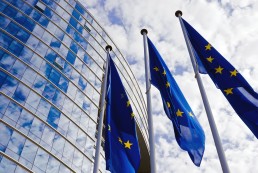Huawei Smartphone Exports Drop but Chinese Sales Rise After US Ban
Firm Flies on as a Shot-Up Shturmovik
In an interview on July 4 with the Financial Times, Huawei founder Ren Zhengfei revealed that this is his favourite image of his company — a photo of a shot-up Shturmovik, a Russian Il-2 ground-attack aircraft riddled with shell holes but still in the air. Produced by the thousand in the Second World War, the slow-moving Il-2 had a reputation for being able to take fearful punishment and still fly on, as it does here.
Just as the Il-2 was armoured around the engine, fuel tank and crew, and could take widespread hits in the wings and elsewhere in the fuselage, Zhengfei argues that as long as Huawei is protected around its key internal capabilities, short-term impacts to its sales do not compromise its long-term survival.
Here is an IDC assessment of “battle damage” in the second quarter where Huawei was most immediately vulnerable — its smartphone sales.

Huawei announced on July 30 that its revenues were up 23% in the first half of 2019, continuing the upward climb of recent quarters, and that it sold 118 million smartphones — 24% growth over the first half of 2018.
This upbeat announcement made light of the impact of the US adding Huawei to the so-called Entity List, which prohibits US corporations from commercial relations with it.
US Decision Estimated to have Brought Down Smartphone Sales by a Third
The US announced it would add Huawei to the Entity List in the middle of May, already halfway through the second quarter, which meant that only one half of shipments could be affected by the ban. If Huawei had continued the momentum it had managed in the last couple of quarters, it might well have shipped more than 75 million devices during 2Q, bearing in mind its recent upward momentum. In the event, it shipped 58.7 million, according to the IDC Worldwide Quarterly Mobile Phone Tracker. From this, it would appear that shipments in the second half of May and in June were brought down by at least a third by the ban. In a comment in the first week of August, Richard Yu, the head of Huawei’s consumer businesses, put the effect of the ban to date at around 10 million smartphones.
Huawei maintained the strongest momentum in the second quarter in Asia/Pacific, with shipment growth of nearly 17% year on year and around 13% over the last quarter. But this was all down to China, where shipments rose in the second quarter by 27% to an all-time high of 36.3 million phones. Huawei’s share, which had been increasing in the last few quarters, also hit a record, of 35.3%.
Huawei’s exports in Asia/Pacific to countries outside China, at 2.74 million, were down by more than two-fifths over the previous quarter.
Europe is the most important export region for Huawei. Looking at the region at its broadest and including Russia, it accounts for towards half of all its exports. These were pushed down to around the same level as in the same quarter last year, cutting out big increases in the intervening quarters.
Exports Fell from Half to Two-Fifths of Production
The Honor brand did not prove less susceptible to the ban than the main Huawei brand; in fact, the opposite was true, with Honor shipments taking more of a hit. A reason for this may have been that the Honor 20, the latest flagship phone to be launched (on June 21 in Europe), was seen by consumers as a risky purchase in terms of future Android support, as Google announced after the Entity List decision that it would be able to provide commercial support (i.e., preload access to the app store and Gmail support) on future Huawei models but would continue to do so for existing ones. Huawei did not extend its reassurance of money-back guarantees to buyers of Huawei brand phones to Honor devices, and my colleagues in Asia/Pacific believe that Honor suffered in this region as a result.
What access Huawei will have in future to commercial relations with US companies is still unclear. President Trump announced on meeting Chinese leader Xi Jinping at the G20 meeting in Hawaii at the end of June that Huawei would be able to have such arrangements as long as there were no threats to national security, which appeared to imply that Huawei’s smartphone operations could be back to normal with US suppliers. The US Justice Department later said that while Huawei would stay on the Entity List, waivers would be issued for specific cases.
Future Commercial Relations with US Companies Still Unclear
As I write this, at the beginning of August, very few further details of which US companies will be allowed to have contracts with Huawei have emerged, and no announcements have been made on any waivers that have been approved.
So Huawei’s smartphone operations will be weighed down through at least the first half of the third quarter by much of the same uncertainty.
The head of Huawei’s smartphone operations, Richard Yu, admitted on August 8 that the company’s target of 300 million smartphones was now problematic. A figure of at best 250 million now looks more probable.

Huawei no longer has much chance of overhauling Samsung as the number 1 global smartphone vendor this year. In Europe, mobile operators have reported that the Korean firm has been the main beneficiary of Huawei’s problems with the US government, with the other smaller Android brands rarely taking much of the share that Huawei has relinquished. Samsung’s shipments went up 6.0% year on year in 2Q to a global figure of 76.2 million. Its share against Huawei was up, though only marginally on the previous quarter.
Samsung should retain its crown this year
The Big Three Chinese rivals to Huawei, Xiaomi, Vivo, and OPPO, had a respectable quarter, but they did not gain noticeably in export markets. Together, the Top Five global Android vendors, these three Chinese players plus Huawei, and Samsung accounted for 75.4% of Android shipments, against 74.3% in Q1 – so the consolidation trend continued despite Huawei’s travails.
One of the reasons the smaller Android brands are not making a big push against Huawei while it is weak is that they are expecting Huawei to unleash a big new marketing campaign if its status with US suppliers for its smartphones is normalised.
Even if that normalisation occurs fairly soon the company has taken a big knock from which to recover. Going back to the photo at the beginning of this blog, Bloomberg said that founder Ren Zhengfei said in early August in an internal letter to staff that this last quarter “Two bullets fired at our consumer business group, unfortunately, hit the oil tanks,” so the shturmovik was not just hit in the wings.

If you want to learn more about this topic or have any questions, please contact Simon Baker or head over to https://www.idc.com/eu and drop your details in the form on the top right.
Winning the Customer's Heart — Building New Business Models
In today’s digital economy, companies are increasingly recognizing the importance of delivering an experience that makes them stand out from their competition.
According to IDC’s European Vertical Markets Survey 2018-2019, 46% of European companies ranked customer experience as their top business priority for this year.
There is significant opportunity to disrupt a competitor or gain market share in an industry by becoming customer-focused and deploying a direct-to-consumer (D2C) model or partnering with relevant stakeholders in the wider ecosystem.
Consumer-facing brands in particular are investing in direct sales by beefing up their ecommerce sites and opening stores that act as a physical extension, such as Amazon Books or sports apparel company Under Armor, which generates approximately 35% of its revenue from direct-to-consumer operations.
Focusing on customer experience may well be the single most important investment a company can make in today’s competitive business climate.
For one, it helps organizations addressing a new generation of customer that is more demanding than ever. With the rise of mobile and social, customers have a voice that can directly impact a brand, and they will not hold back if they have had an unsatisfactory experience. Today’s consumer will want everything now, at the click of a button, customized, with discount options, the assurance that they can return the purchase if it doesn’t meet expectations (customer service), and perhaps most importantly, the expectation that it can be delivered the next day, if not earlier.
Another advantage of engaging the customer directly or through non-traditional ecosystem players is the opportunity for new revenue generation. In fact, direct engagement allows brands to receive real-time product feedback from their customers and collect other valuable data, including behavioral patterns and preferences, which in turn helps to improve the customer journey and allows the targeting of customers with more personalized products or services.
D2C is still a new frontier for many companies, and in most cases it requires looking at the business in a whole new way, rather than just making new technology investments. However, there are some interesting cases emerging already across industries in D2C and other models involving wider ecosystem partners, including in manufacturing, retail, and insurance. Here are some industry examples which demonstrate how companies compete for customer attention through business model transformation.
Adidas Shapes the Future of Customer Experience by Re-localizing its Manufacturing Process
To respond quickly to customers’ demand for personalized footwear, German sportswear manufacturer Adidas set up two state-of-the-art factories called the Speedfactory — one at the Adidas HQ in Germany and the other in Atlanta, Georgia. These factories are nearly fully automated, operating on a mix of 3D printing, robotics, and computerized knitting. With this production overhaul, Adidas no longer operates on a traditional supply chain model that relies on manual production in Asia, where most Adidas shoes are made across a network of factories. Instead, the localized approach concentrates the sneaker-production process in a single space and in the market where the shoes are sold.
Enabled by the Speedfactory, Adidas was able to launch localized shoe design, such as the AM4LDN, which is creating unique shoes for individual cities, tailored to meet the needs of its residents. For instance, Londoners wanted a reflective shoe, with an extra grippy outsole to deal with the grey London drizzle. The sneakers have near-field communication (NFC) chips embedded, allowing customers to access original content in the Adidas app. However, the chips also deliver valuable data to Adidas, allowing the manufacturer to improve and customize their shoes continuously.
Typically, it takes Adidas 12–18 months to take a shoe from concept to store. Just one style of shoes relies upon several factories across Asia. The Speedfactory has changed all that, taking production down from months to a single day. Adidas also saw a 28% net sales share increase from speed-enabled products in 2017.
Another outcome of the Speedfactory is the Adidas Glitch football (soccer) boot. The boot consists of an inner sole, which is custom made to fit the shape of any foot, and an outer shell, which is interchangeable at any time, and once ordered will be hand delivered within only four hours. But again, this highly tailored, mass-produced product requires leveraging next-generation smart manufacturing principles.
Travelers and Amazon Launch a New Partnership to Deliver Value-centric Experiences.
Traditional sectors such as insurance are starting to respond to the changing expectations of their customers by exploring cross-industry partnerships. Insurance products typically address specific coverage needs and products are priced based on associated risks. Customers now expect value beyond standard coverage and services to stay loyal. They also expect value-added offerings (e.g., loyalty discounts) to be tailored to their specific needs and circumstances. Insurers are waking up to the fact that delivering contextual, holistic, and value-centric experiences that address policyholders’ specific needs and preferences is vital to thrive in the digital era and build brand loyalty. This is possible only through partnering with wider ecosystem stakeholders (e.g., with retailers to offer loyalty discounts; with media houses to offer infotainment services for risk prevention; with fitness clinics to promote active lifestyles).
One example is the collaboration between Amazon and Travelers insurance. Under the partnership, the insurer will offer smart home kits (security cameras, water sensors, motion detectors, and a wireless hub), as well as insurance and risk management information via a “digital storefront” at Amazon.com/Travelers. Insured customers can get a discount on their home insurance and receive a free Amazon Echo Dot. The solution aims to extend the insurer’s lead in risk expertise and provide great experiences for customers and agents, also leveraging interactive conversational speech technologies (with Amazon Alexa skills developed for Travelers) that enables new ways to interact.
The discounts and free Amazon Echo Dot were available to Travelers home insurance customers in only 3 U.S. states at launch, but 11 more states were added soon after. Travelers plans to continue to build upon the initial momentum and expand further.
Customer-Experience-Based Business Models are the future of the enterprises requiring increasingly contextual information and more advanced technologies to transform data into actionable insights.
The IDC European CX Practice has identified three key aspects that are supporting these new business models: Consent, Conversations, Customer Journeys.
Tackling the Digital Skills Gap
In this recent blog post (well worth a read) IDC’s Marianne Kolding identifies the challenge faced by organisations looking to accelerate their Digital Transformation programmes in the face of ever-increasing competition. Digital skills are not keeping up with demand with IDC research showing that this will lead to $90 billion lost revenue in Europe in 2020. There is evidence that data science and machine learning expertise will be in the greatest demand.
Organisations thinking of joining the battle for this talent should beware using their traditional methods – digital transformation programmes are not a one-off event after which a company suddenly achieves “digital” status. Working in a digital world requires a constantly evolving toolset and a different approach to the skills you need. Many people who work with these emerging technologies have the networks and abilities to work with organisations of many kinds. They don’t necessarily want to engage with your management hierarchy and HR evaluation process. They are to be found working for boutique consultancies, software development shops, start-ups and as freelancers.
If you expect to be able to hire all these people and have them in your team over the long term of a digital transformation programme, the chances are you will be disappointed. Rather, take the time to understand how to blend your skill base depending on your needs using permanent, contract and people from third party suppliers. Make sure that when people leave your teams they do so having been able to deliver unencumbered by politics and bureaucracy, as part of a team that is focused on successful outcomes, not corporate snakes-and-ladders. They will go out to their networks and tell the stories of how they had a great time working with you and their peers will want to come to you too. Be the kind of place your target talent wants to work, whether that’s a short term gig or something more substantial.
In September I’m speaking at the 2019 IDC CIO Summit in Bratislava, Slovakia – where we will explore the strategic choices that will shape the future at the confluence of technology and business. Forward-looking CIOs, executives, industry leaders, and IDC experts will reveal strategies, tactics, and technologies that make the difference.
European Commission to Create GDPR Equivalent for AI
New European Commission (EC) President Ursula von der Leyen looks like she could be instrumental in pushing a significantly changed regulatory environment for the development of artificial intelligence in Europe — marking a stark departure from the EC's approach under predecessor Jean-Claude Juncker, who chose not to legislate on the area.







